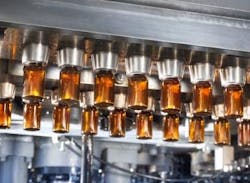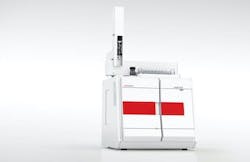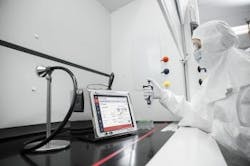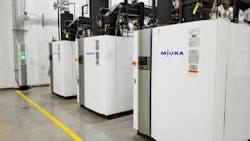2020 likely will not go down in history as a year of celebration.
As the entire world struggles to control a ruthless pandemic, large in-person events have come to a screeching halt. Weddings, retirement parties, graduations and yes, pharma trade shows, have been postponed, made virtual or outright cancelled. Convention centers that once buzzed with the chatter of networking and hum of new equipment, now sit vacant and eerily quiet — or in some cases, have been converted into emergency field hospitals to provide relief to overflowing hospitals.
In more normal times, the editors of Pharma Manufacturing spend the year traveling to trade shows and events, hand-picking unique manufacturing products for our annual Pharma Innovation Awards. But 2020 is all about pivoting. While some of this year’s winners were lucky enough to hit the scene before the pandemic brought in-person events to a stop, others entered the marketplace without the fanfare of big trade show launches.
Fortunately, pivoting is nothing new for equipment and technology vendors. In many ways, innovation is about staying relevant; the most innovative vendors are often those who best adapt to meet the changing needs of their customers. This month’s cover story is a tribute to those who create products that cater to the specific needs of pharma manufacturers, and as a result, have distinguished themselves as leaders in pharmaceutical equipment and technology.
With that said, we are proud to introduce this year’s Pharma Innovation Award winners: 11 recently launched or updated technologies, systems and services chosen by editors and reviewers for the potential value and innovation they bring to the pharma industry.
Biopharma
At the start of 2020, the biopharma industry was healthy, with the global market for biopharmaceuticals surpassing $275 billion, growing around 12 percent annually. Much of the biopharma buzz was surrounding new treatments and modalities, especially in areas such as gene therapies, oncology and Alzheimer’s disease treatments. At the same time, the industry was facing political volatility, pricing pressure, staff shortages, global economic concerns, and competition from biosimilars. When the pandemic hit and the world began looking to biopharma companies for COVID-19 treatments and vaccines, the industry’s need to quickly and efficiently mobilize was further reinforced.
This year’s biopharma award winners address key necessities in biopharma processing, including the need for greater manufacturing efficiency and speed, real-time process control and reduction of downtime between batches.
Speeding therapies to market
Monoclonal antibody drugs (mAbs) make up more than 50 percent of the biologics on the market today, as well as a significant amount of pipeline drugs. mAbs treat a wide variety of conditions including cancer and autoimmune diseases. Currently, much of the bottleneck when it comes to delivering mAb therapeutics is within the downstream processing stage.
Protein A affinity chromatography is a proven and widely used downstream purification step in manufacturing mAbs, and protein A resins are the most frequently used affinity resins in biomanufacturing. Yet, there remains a need in the industry to reduce the total purification costs while improving purity and yield. Avantor’s J.T.Baker BAKERBOND PROchievA, a recombinant protein A affinity chromatography resin based on an optimized, affinized ligand and linker chemistry, responds to the industry’s need for greater efficiency in mAbs processing, helping to bring life-changing therapies to market faster.
Entering a space where competition is still needed, the BAKERBOND PROchievA resin has been performance tested against other protein A resins on the market, and has demonstrated best-in-class dynamic binding capacity for mAbs and improved purification results in Fc-Fusion proteins and other molecules. With the new resin, Avantor offers an independent chromatography resin supply alternative to other commercially-available purification products, providing greater supply chain flexibility and security.
Scalable, real-time bioprocess monitoring
Raman spectroscopy is used in biomanufacturing as a process analytical technology (PAT) tool, enabling rapid, non-destructive, in-process measurements. However, since there was previously no interface to bioreactors less than 250 mL, Raman data collection at early stages of bioprocess development has been lacking. Realizing the industry was struggling to capitalize on the full potential of Raman spectroscopy, Kaiser Optical Systems, an Endress+Hauser company, collaborated with Sartorius to bring Raman to micro-bioreactors (10-15 mL) and mini-bioreactors (100-250 mL).
Controls for the bIO-PRO, KS and Kaiser Raman embedded analyzers have been incorporated into Sartorius’ software for ease-of-use and data consolidation. Users can now realize QbD and PAT more easily, quickly and affordably. Our next winner, the new Kaiser Raman bIO-PRO, KS probe, has been adapted to fit Sartorius’ BioPAT Spectro platform for Ambr and Biostat STR, enabling Kaiser Raman-based Quality by Design (Qbd) early on in process development through scale-up to commercial manufacturing. The probes are optimized specifically for bioprocesses and are known for having high-quality contact materials, flexible sampling capabilities, and rugged designs for lab-to-GMP. This collaboration enables non-contact Raman collection, so no cleaning, sterilization, or frequent probe maintenance is required. In addition, the bIO-PRO, KS probe includes self-alignment and calibration innovation for enhanced analytical method transfer capabilities.
Enabling single-use
Many biopharma manufacturers are finding that systems using single-use elements, such as disposable bioreactor bags, eliminate many of the problems experienced with stainless steel equipment as well as provide additional advantages. But single-use methods introduce their own challenges, especially with the integration of measurement instrumentation in the bioreactor.
Traditional instrumentation can be cumbersome and costly to integrate into single-use bioreactor bags, creating a need for instrumentation technology designed specifically for single-use biomanufacturing. Our next winner, the Rosemount 550PT Pressure Transmitter from Emerson, fills that need. The reusable pressure sensor is designed to provide the same proven performance as traditional stainless steel technologies while being uniquely adapted to fully meet the needs of single-use.
The transmitter provides immediate start-up, connected through a standard tri-clamp. It allows for stable measurement with batch-to-batch pressure measurement consistency and can reduce costs and downtime between batches. The unit is designed to work with the Rosemount 551 Single-Use Process Connector to isolate fluid from the sensor, increasing safety and reducing process contamination risks.
Smart pharma
Much has been written about how digitalization will progress in the “risk-averse” pharma industry. Most pharma professionals acknowledge that digital technology will absolutely play a widening role in pharma’s future, but not without the industry overcoming significant hurdles.
The pandemic put pharma’s digital progress to the test — and according to this year’s annual Pharma Manufacturing Smart Pharma survey results, the industry is performing better than anticipated. Formerly “nice to have” digital technologies, such as remote collaboration tools, became essential for continuing operations amid the pandemic.
But even prior to the pandemic, one area of the plant that has been transformed by IIoT is equipment maintenance. Smart technology has the ability to take maintenance to a new level — enabling plants to transcend the traditional preventative style of regularly scheduled maintenance to a condition-based predictive maintenance.
Our winning smart pharma innovation comes from a collaboration between BISTel and Korea’s largest mobile operator, SK Telecom. The pair launched the GrandView Asset Performance Management (APM) solution at last fall’s AWS Re-invent trade show in Las Vegas. The Grandview APM solution integrates SK Telecom’s big data analytics and IoT technology platform with BISTel’s manufacturing and engineering expertise, and the result is a solution that provides for continuous monitoring of the health and performance of factory equipment, pumps, motors, fans, and other critical assets and showcases powerful data visualization for all users.
The asset health index and AI predictive analytics technology provides users with an RUL (remaining useful life) prediction, pinpointing when assets will fail. Users can connect the GrandView APM’s prediction to their plant’s CMMS, EAM or ERP systems, automatically generating a work order scan to order parts and perform maintenance — thus minimizing or even eliminating system downtime.
The cloud-based solution’s AI enabled applications and reporting could be game-changers, providing pharma manufacturers 100 percent visibility into the performance of their equipment, production processes and engineering systems. Importantly, BISTel says the Grandview APM offers easy data integration with ERP, MES and supply chain management systems and requires minimal IT support. The smart application can access and gather information from formerly siloed environments across the pharma plant to create new insights that can help deliver drug products to market faster, with less risk, made by equipment that lasts longer.
Packaging
While packaging might seem like a simple means of transporting drugs from one place to another, choosing the right packaging is a complex issue vexing drugmakers — especially with the rise of modern biologics that are more sensitive to degradation.
Additionally, the pandemic has shined the spotlight on specific packaging challenges. As biopharma works painstakingly to develop safe and effective COVID-19 vaccines, concerns have been raised about sourcing enough vials to package the final products. Drugmakers must contend with the possibility of limited glass packaging supplies, with the added complexity of unique cold storage needs during transport.
Bormioli Pharma: Pharma-grade rPET bottles
While the pandemic has definitely put new pressures on packaging, traditional packaging obstacles have not abated. Our winners in this category tackle two different but equally important challenges: One is offering drugmakers a compliant and sustainable plastic packaging solution and the other is making it easier for drugmakers to test different packaging platforms.
Sustainable options
Saving our environment will require industries to make changes, and pharma manufacturing is no exception to this call for action. Globally, plastic packaging is under scrutiny, facing stricter regulations and strategies aimed at reducing plastic waste and ensuring more plastic is recycled. And while pharma packaging hasn’t been put in the hot seat yet, it is only a matter of time before the industry is directly called upon to make improvements.
Pharma Manufacturing editors got their first glimpse of our next winner while visiting the company’s brightly lit “experiential installation” during CPhI Worldwide 2019. At the time, Bormioli Pharma was showcasing multiple packaging prototypes, addressing key customer needs. Now, the Italian company’s winning pharma-grade rPET bottles — which Bormioli Pharma says are among the first sustainable plastic packaging solutions for the pharma industry — are currently being validated by pharma companies.
The new bottles can be manufactured with up to 100 percent pharma-grade post-consumer recycled PET. The plastic is transformable exactly like virgin PET, allowing the creation of customized solutions. The plastic packaging is compliant with European Pharmacopoeia standards and has also been rated suitable for food contact.
Of note, this is Bormioli Pharma’s second appearance on the Pharma Innovation Awards list, having won the honor two years ago for its AccuRec dual chamber packaging. The company, which has made innovation part of its corporate culture, seems to always have its ear to the ground when it comes to customer needs.
Choosing the right packaging
When pharma manufacturers develop drugs that are particularly sensitive to oxygen and moisture, they need to select packaging that best preserves the drugs’ efficacy and stability. Determining this ideal packaging solution — one with precisely the right barrier properties — has been an ongoing challenge within the industry. Drugmakers and CMOs often utilize in-house small-scale blister packaging equipment in order to test the barrier properties of their new drugs.
But the traditional metal tooling prototypes needed to create different types of blister packs can be prohibitively expensive and take weeks to create. Maruho Hatsujyo Innovations (MHI), the U.S. subsidiary of Osaka-based Maruho, a major Japanese health care company, offers relief to these issues with its 3D-printed tool prototyping service.
Using 3D printing technology — a favorite example cited by the U.S. Food and Drug Administration during discussions of “emerging technology” — MHI can create multiple tooling prototypes. These 3D-printed prototypes are ideal for use in test situations, allowing drugmakers to create sample blister cavities that are nearly identical to final production. The technology provides blister prototypes in days rather than weeks, at a cost lower than metal tooling, allowing drugmakers the leeway to try new or modified packaging platforms.
Monitoring and analytical devices
The pharma industry prides itself in producing safe, quality products in accordance with regulatory standards and guidelines. When it comes to environmental monitoring and process validation, pharma needs the right tools to collect and analyze data. Not only can this data be used to prove compliance, it can also be used to improve manufacturing protocols and product quality.
This year’s winners are two essential tools for detecting impurities, offering pharma manufacturers automated, compact options to add to their compliance arsenal.
Vaccine QC
In vaccine production, starting, intermediate and end products need to be controlled for the level of antigens, the molecules in charge of triggering immune response. Since these antigens typically consist of proteins, the analytical quantification of total protein is a method of choice.
Our next winner, the multi N/C 2100S pharma analyzer from Analytik Jena US, is the only analyzer designed for protein determination in vaccine quality control, according to the company.
Analytik Jena US: Multi N/C 2100S pharma analyzer
The compact and robust routine analyzer is equipped with a CLD (chemiluminescence) detector for total nitrogen determination and is the optimum system to perform total protein analysis for such samples according to the catalytic high temperature digestion method. CLD detection provides efficient protein analysis in vaccine production or total nitrogen cleaning validation with minimal sample consumption and a high degree of automation. The analyzer is ideal for particle- or oil-containing samples as well as very small sample volumes.
Compared to other methods, the multi N/C 2100S pharma provides significantly easier and fully automated operation, and high sample throughput. Integrated quality control features including a system suitability test and self check system allow reliable operation and precise results in routine and research analysis.
Improving data integrity
Routine environmental monitoring in GMP cleanrooms can be a manually intensive process. It typically involves collecting thousands of samples every month, with technicians having to configure the particle counter at every sample location according to SOPs, and manually transcribe the results from paper print-outs into a computer. Not surprisingly, this process is prone to human error that can ultimately result in data integrity issues.
With its MET ONE 3400+ series portable air particle counter, Beckman Coulter Life Sciences seeks to completely automate routine environmental monitoring. Launched this summer, the particle counter enables cleanroom users to import their SOP routine environmental monitoring maps and sampling configurations into the counter itself, creating an interactive map of the cleanroom on the counter screen. The technician follows the map and simply taps the sample location on the interactive map; the counter does everything else — reducing training requirements and human error. Interactive, on-screen tracking instantly shows on-site users which locations have been sampled so they can monitor their progress at a glance.
Beckman Coulter Life Sciences: MET ONE 3400+ series
All electronic records inside the counter are reviewed and approved remotely (using electronic signatures) simply using a web browser, then securely exported. There is also a built-in audit trail capturing all events. This model is the newest member to join a series of particle counters that Beckman Coulter says offer the industry’s first fully ALCOA compliant solutions for FDA 21CFR part 11 — helping make data access fast and efficient during the audits required to maintain GMP manufacturing status.
Plant operations
Plant operations is a broad category, encompassing vital needs such as maintaining plant floor equipment, monitoring utilities and managing services. Often cited as the area of pharma most ripe for innovation, the plant floor offers ample opportunity for companies looking to gain a competitive edge.
Pharma manufactures are seeking to reduce risk, increase efficiency and cut costs. Whether it’s through innovative applications of existing technology or the outsourcing of services to allow pharma to focus on core competencies, this year’s winners offer exciting options.
Aseptic powder transfer
As pharma companies continue to utilize multiple locations for the development, manufacturing and packaging of products, assuring the integrity of expensive, sensitive powders while in transit is an ongoing challenge. Manufacturers have turned to common packaging solutions such as fiber or plastic drums with flexible liners to meet their transportation needs, but these packaging solutions can create additional obstacles when it comes to filling, sealing, handling and emptying.
ChargePoint Technology’s Multi-Site Powder Transfer solution offers a simplified, controlled and cost-effective answer to this problem. Debuted at CPhI Worldwide 2019, the single-use solution was created by combining the ChargePoint SUP, a disposable version of the passive mating half of the company’s split butterfly valve, and ChargeBag PE-S single-use packaging. Together, the two products form a high performance, single-use package for the contained and sterile transfer of pharmaceutical powders between manufacturing process steps or even facilities.
Constructed completely of FDA and United States Pharmacopeia (USP) Class VI compliant materials, the ChargePoint SUP delivers containment and sterility assurance while eliminating the time and cost associated with cleaning, maintenance and validation. The ChargeBag PE-S is made with the company’s pharma-ready HiPure ULP7 film offering high levels of integrity related to regulatory qualification, as well as robustness and anti-static properties. The resulting hybrid solution allows users to take advantage of the benefits of disposable technology without compromising performance.
Miura America: Steam-as-a-Service
Outsourced steam
Whether it’s being used in HVAC installations, production processes or sterilization, generating quality, “clean” steam is important to the pharma industry. But between maintenance, monitoring, pressure concerns and leaks, steam generation systems can be cumbersome for facility managers.
Our next winner offers pharma manufacturers a new approach to steam generation. Unveiled in early February at AHR 2020 (an air-conditioning, heating, and refrigerating expo), Steam-as-a-Service (SaaS) offers a more scalable clean steam generation model. The new turnkey solution brings together three leading steam companies — boiler manufacturer Miura America; thermal utility manufacturer and provider Armstrong International; and equipment insurance and inspection company Hartford Steam Boiler.
Steam-as-a-Service delivers state-of-the-art equipment, next-gen IoT capabilities, and expert onsite operation and maintenance — for one, predictable monthly payment. The service is ideal for a range of users, from those with an aging steam infrastructure that is operating beyond its optimal life span, to customers with new steam needs looking to design, build, operate, maintain, and continuously optimize their steam generation onsite, while focusing on their core business and “future-proofing” their steam requirements.
Users are given insurance-backed guarantees for performance, reliability and efficiency. Steam is guaranteed without worrying about liability risks, compliance issues or equipment failures.
Real-time virtual support
With the pandemic halting travel and pushing the world towards virtual solutions, our next winner fills an increasingly important plant floor need. Earlier this spring, MG America, the U.S. subsidiary of Italian equipment supplier MG2, introduced a Remote Technical Assist (RTA) program for its processing and packaging machinery. Designed to drastically reduce machine downtime and operator error, the comprehensive equipment assistance initiative features emergency support, line integration and training sessions.
Performed via 100 percent secure WiFi, 3G/4G or ethernet connection, the RTA program allows line personnel to hear, speak with and even see technicians trained in specific MG America packaging and processing equipment. Sessions can include live streaming, instant messaging, file sharing, pics/screenshots and annotations.
Remote Technical Assist can also be used as a training tool. Virtual sessions allow workers to become proficient in the operation of new machines rapidly. Skills upgrade sessions that bridge the knowledge gap between new employees and veterans also are available. These on-demand virtual primers are designed to improve retention and optimize worker performance.
And that’s a wrap for the 2020 Pharma Innovation Award winners — new technologies and services that give cause for celebration. Congratulations to the winners. Thank you for listening to the needs of your customers and the market, and tirelessly working towards a better pharma industry.
About the Author
Karen P. Langhauser
Chief Content Director, Pharma Manufacturing
Karen currently serves as Pharma Manufacturing's chief content director.
Now having dedicated her entire career to b2b journalism, Karen got her start writing for Food Manufacturing magazine. She made the decision to trade food for drugs in 2013, when she joined Putman Media as the digital content manager for Pharma Manufacturing, later taking the helm on the brand in 2016.
As an award-winning journalist with 20+ years experience writing in the manufacturing space, Karen passionately believes that b2b content does not have to suck. As the content director, her ongoing mission has been to keep Pharma Manufacturing's editorial look, tone and content fresh and accessible.
Karen graduated with honors from Bucknell University, where she majored in English and played Division 1 softball for the Bison. Happily living in NJ's famed Asbury Park, Karen is a retired Garden State Rollergirl, known to the roller derby community as the 'Predator-in-Chief.'




